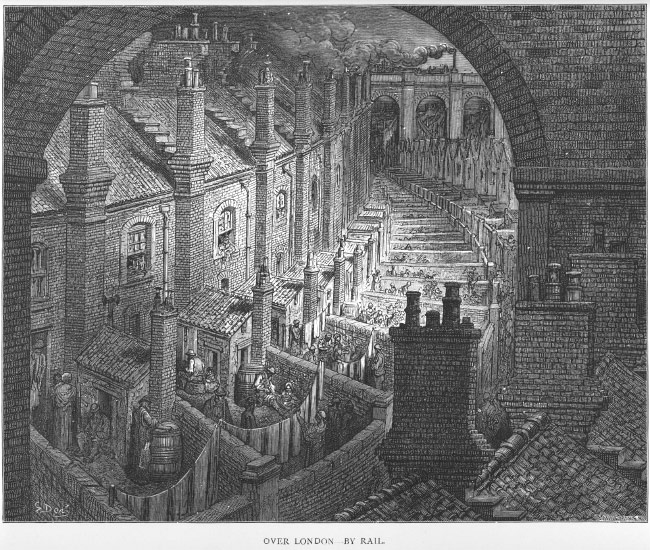So, I’ve had an idea – been nursing it for a little while.
The idea is to try and put together a list, of things that I find interesting from history, things that I’d like to see in a New Weird or Steampunk or Fantasy setting. History is an interesting place, one that you can drop in and visit, but one that (fortunately) you cannot live in. For all those people out there who just started thinking about how swell it would be to live in a Steampunk setting, in Victorian London, I’ll just point you in the general direction of some history books, and this article I wrote a little while back about what I like to call Slumpunk. Some of them I’ve already seen in those settings, so, when we come to those, I’ll point you in that direction.
To give you an idea of what, exactly, it is I’m talking about, here’s the first in this little series of demi-articles:

Gustav Dore – “Over London”
SPANKO!
The Whipping Toms
London has always been a weird place. And the past is also a weird place, when seen through the lense of our cultural understanding – and it’s these little quirks that make the city such a grand setting for Urban Fantasy stories, like Neil Gaiman’s Neverwhere, China Mieville’s Kraken, or Ben Aaronovitch’s Rivers of London (all great books, by the way).
Today we’re going to look at a peculiar character in the history of London, whose career started in 1672, after the English Restoration, the reign of King Charles the Second.

Charles the II, looking banging in those trousers.
The character in question is one who went by the name of “Whipping Tom” – at the time, Tom was a slang term for a man. So I think we can figure out what this particular Tom was famous for. He , to quote a publication from the time, “proved such an Enemy to the Milk-wenches Bums.” There were, apparently, three separate ‘Whipping Toms’: the first we have only rumours of, operating around 1672 – only whispers in history remain about this chap. The stories of these “Whipping Toms” fall into the narrative of the time – men have been wary of women at least since Juvenal penned his Sixth Satire, a tradition that includes William Walsh, Robert Gould, and Henry Fielding.
The second Whipping Tom began his furious paddling of women’s bums in 1681 – working in and around Fleet Street (which ran (and indeed still does) from the City of London to Westminster, and has been home, not only to the British newspaper industry, but also to people like Ben Johnson, John Milton, John Dryden, and Samuel Johnson), the Strand, and Holborn, Whipping Tom (II) worked in and out of the courtyards and narrow alleyways that London offered him. When he came across an unaccompanied woman in these dark little corners of the city, he would grab her, lift her skirts, and smack her bottom, often shouting out a victorious “Spanko!”
His first Adventure, as near as we can learn, was on a Servant Maid in New-street, who being sent out to look for her Master, as she was turning a Corner, perceived a Tall black Man standing up against the wall, as if he had been making water, but she had not passed far, but with great speed and violence seized her, and in a trice, laying her cross his knee, took up her Linnen, and lay’d so hard up-on her Backside, as made her cry out most piteously for help, the which he no sooner perceiving to approach (as she declares) then he vanished.
Whipping Tom Brought to Light and Exposed to View – Edward Brooks, 1681
This Whipping Tom was seen as a devil, or in a supernatural light by Londoners – he struck with lightning speed before disappearing. Women began carrying weapons, hidden under their clothing, and vigilantes began dressing themselves as women, hoping to catch the Whipping Tom’s eye. A haberdasher was eventually arrested and tried with the crimes, but we have no record of whether he was convicted, or what the punishment was.
The attacks died down.
Until 1712, when a rash of new assaults broke out in the fields near Hackney. This time, the Whipping Tom (III) was striking his victims with a “Great Rodd of Birch”, rather than his bare hands. There were no shouts of “Spanko!” either. There were about 70 victims, of this third Whipping Tom, some of them seriously injured, before one Thomas Wallis was arrested and confessed to the crimes. His motive was an old one – spurned and betrayed by the woman he loved, he sought to punish all women. Another reason he voiced was that he feared that men were becoming slaves to women. He was charged with “exposing many a pretty female’s backside to the extremity of the wind and rainy weather.” His punishment? He was sentenced to be caned with a club of birch, by two “strong-armed lasses”, every week for a year.
Sources:
Bondeson, J, The London Monster: A Sanguinary Tale, London: Da Capo Press (2002)
Burg, BR, Sodomy and the Pirate Tradition, New York: New York University Press (1995)
Nussbaum, F, “Juvenal, Swift, and the Folly of Love”, Eighteenth Century Studies, 1976
Traister, B., “Imagining Sex: Pornography and Bodies in Seventeenth Century England”, Renaissance Quarterly, 2009

When a problem comes along
You must whip it
Before the cream sets out too long
You must whip it..
Love it!
[…] Here’s the first: SPANKO! […]